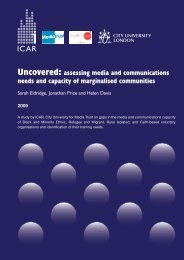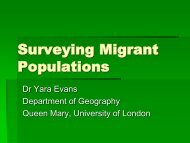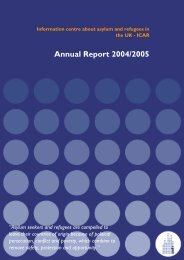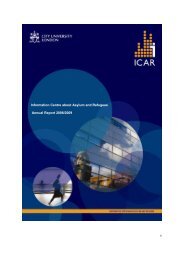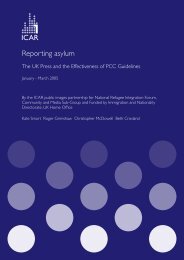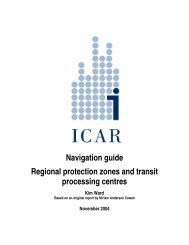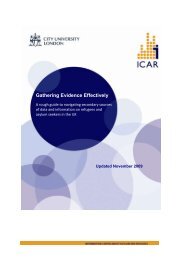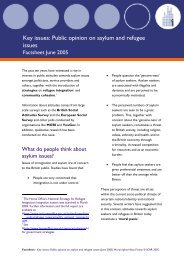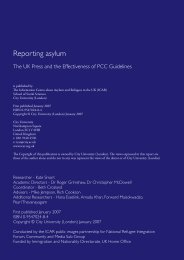ICAR briefing - The Somali Refugee Community in the UK
ICAR briefing - The Somali Refugee Community in the UK
ICAR briefing - The Somali Refugee Community in the UK
You also want an ePaper? Increase the reach of your titles
YUMPU automatically turns print PDFs into web optimized ePapers that Google loves.
<strong>ICAR</strong> Brief<strong>in</strong>g – July 2007<strong>The</strong> <strong>Somali</strong> <strong>Refugee</strong> <strong>Community</strong> <strong>in</strong> <strong>the</strong> <strong>UK</strong><strong>Somali</strong>a’s <strong>in</strong>ternal crisis has <strong>in</strong>tensified over <strong>the</strong>past 12 months creat<strong>in</strong>g widespread populationdisplacement. Significant events have <strong>in</strong>cludedJune 2006, when <strong>the</strong> Union of Islamic Courts(UIC) took control of <strong>the</strong> capital, Mogadishu; <strong>the</strong>recaptur<strong>in</strong>g of Mogadishu by Ethiopian-backed<strong>Somali</strong> forces oppos<strong>in</strong>g <strong>the</strong> UIC 1 <strong>in</strong> December2006; <strong>the</strong> US bombardment of suspected AlQaeda targets <strong>in</strong> <strong>the</strong> South of <strong>the</strong> country <strong>in</strong>January 2007 2 ; and <strong>the</strong> deployment of AfricanUnion troops and clashes between <strong>in</strong>surgents andEthiopian troops particularly <strong>in</strong> Mogadishu 3 . <strong>The</strong>fight<strong>in</strong>g has added to <strong>the</strong> official IDP populationwhich currently stands at 400,000 accord<strong>in</strong>g to<strong>the</strong> Internal Displacement Monitor<strong>in</strong>g Centre 4formation of an <strong>in</strong>terim government <strong>in</strong> 2000 andaga<strong>in</strong> <strong>in</strong> 2004. 6Given <strong>the</strong> current media attention, and <strong>in</strong> light of<strong>the</strong> country’s long historical association with <strong>the</strong>United K<strong>in</strong>gdom, an <strong>ICAR</strong> <strong>brief<strong>in</strong>g</strong> on <strong>Somali</strong>a and<strong>the</strong> <strong>Somali</strong> community with<strong>in</strong> <strong>the</strong> <strong>UK</strong> is timely.History<strong>The</strong> Republic of <strong>Somali</strong>a was created <strong>in</strong> 1960when both <strong>the</strong> British Protectorate of <strong>Somali</strong>landand <strong>the</strong> UN-established, Italian TrusteeshipAdm<strong>in</strong>istration merged. 5Early <strong>in</strong>dependence was marred by territorialdisputes with both Kenya and Ethiopia. Follow<strong>in</strong>g<strong>the</strong> assass<strong>in</strong>ation of Ali Rashid Ali Shermarke <strong>in</strong>1969, General Mohamed Siad Barre assumedpower <strong>in</strong> a coup. He was deposed <strong>in</strong> 1991 by agroup of clans long excluded from participation <strong>in</strong>government <strong>in</strong> favour of General Barre’s ownclan. A protracted civil war ensued, whichcont<strong>in</strong>ued unabated notwithstand<strong>in</strong>g <strong>the</strong>1BBC (28 December 2006) Islamists abandon <strong>Somali</strong> capitalhttp://news.bbc.co.uk/1/hi/world/africa/6213499.stm2BBC (9 January 2007) US targets Al Qaeda <strong>in</strong> <strong>Somali</strong>ahttp://news.bbc.co.uk/1/hi/world/africa/6245943.stm3BBC (22 March 2007) Battles resume <strong>in</strong> <strong>Somali</strong> Capitalhttp://news.bbc.co.uk/1/hi/world/africa/6478677.stm4 http://www.<strong>in</strong>ternaldisplacement.org/8025708F004CE90B/(httpCountries)/02EE5A59E76049F5802570A7004B80AB?OpenDocument5Foreign and Commonwealth Office - <strong>Somali</strong>a HistoricalBackgroundhttp://www.fco.gov.uk/servlet/Front?pagename=OpenMarket/Xcelerate/ShowPage&c=Page&cid=1007029394365&a=KCountryProfile&aid=1019744993170Source: CIA World Factbook<strong>The</strong> <strong>Somali</strong> peopleClans play a central role <strong>in</strong> Somaili society andpolitics. <strong>The</strong> four ma<strong>in</strong> clans: Darod, Isaq, Hawiyeand Dir are commonly referred to as ‘Noble’clans whose members are believed to share acommon <strong>Somali</strong> ancestry. 7 <strong>The</strong> clan system <strong>in</strong><strong>Somali</strong> society forms not only <strong>the</strong> basis of <strong>the</strong>traditional <strong>Somali</strong> political structure, but alsoprovides both a system of rights and a socialsupport structure. <strong>The</strong> Digil and Mirifle clans aredescribed as occupy<strong>in</strong>g <strong>the</strong> middle groundbetween <strong>the</strong> ‘Noble’ clans and <strong>Somali</strong> m<strong>in</strong>oritygroups. 8 Members of ‘lower’ clans or m<strong>in</strong>oritygroups are frequently <strong>the</strong> targets of persecutionand relatively disasdvantaged. 96 Home Office (January 2007) Country of Orig<strong>in</strong> InformationReport- <strong>Somali</strong>ahttp://www.homeoffice.gov.uk/rds/pdfs07/somalia-150107.doc7Danish Immigration Group (September 2000) Report onM<strong>in</strong>ority Groups <strong>in</strong> <strong>Somali</strong>ahttp://www.unhcr.org/home/RSDCOI/3ae6a5fa0.pdf8Home Office (January 2007) Country of Orig<strong>in</strong> InformationReport- <strong>Somali</strong>ahttp://www.homeoffice.gov.uk/rds/pdfs07/somalia-150107.doc9US Dept of State (March 2006) Country Report on HumanRights Practices<strong>ICAR</strong> BRIEFING – <strong>The</strong> <strong>Somali</strong> <strong>Refugee</strong> <strong>Community</strong> <strong>in</strong> <strong>the</strong> <strong>UK</strong> © <strong>ICAR</strong> 2007 1
o<strong>the</strong>r m<strong>in</strong>ority groups, known as ‘occupationalcastes’ with few or no clan affiliations that havehistorically faced societal discrim<strong>in</strong>ation, <strong>in</strong>clud<strong>in</strong>gexclusion from employment and <strong>the</strong> denial ofownership of property or livestock. 20Historical perspectivesPortCities- London: <strong>The</strong> <strong>Somali</strong> <strong>Community</strong> <strong>in</strong><strong>the</strong> Port of Londonhttp://www.portcities.org.uk/london/server/show/ConNarrative.109/chapterId/2309/<strong>The</strong>-<strong>Somali</strong>-<strong>Community</strong>-<strong>in</strong>-<strong>the</strong>-Port-of-London.html<strong>Somali</strong>s - <strong>the</strong>ir history and cultureCOR <strong>Refugee</strong> Factsheet No.9http://www.cal.org/co/somali/stoc.htmlStatistics on <strong>the</strong> <strong>Somali</strong>community <strong>in</strong> <strong>the</strong> <strong>UK</strong>Although <strong>the</strong>re are no def<strong>in</strong>ite figures reflect<strong>in</strong>g<strong>the</strong> current size of <strong>the</strong> overall <strong>Somali</strong> population<strong>in</strong> <strong>the</strong> <strong>UK</strong>, <strong>the</strong> 2001 Census recorded apopulation of 43,473. 21 <strong>Somali</strong> communityorganisations however, have suggested that <strong>the</strong>number is more likely to be <strong>in</strong> <strong>the</strong> region of90,000. 22Asylum applicationsIn 2006 <strong>the</strong>re were 1,845 asylum applicationsreceived from <strong>Somali</strong> nationals, a small <strong>in</strong>creasefrom <strong>the</strong> 1,760 applications <strong>in</strong> 2005 but less than<strong>the</strong> 2,585 received <strong>in</strong> 2004. Overall <strong>the</strong> numberof <strong>Somali</strong> nationals apply<strong>in</strong>g for asylum <strong>in</strong> <strong>the</strong> <strong>UK</strong>has fallen s<strong>in</strong>ce 1999 when <strong>the</strong>re were 7,495applications. 23 Trends <strong>in</strong> asylum numbers havegenerally reflected <strong>the</strong> course of <strong>in</strong>security andconflict <strong>in</strong> <strong>Somali</strong>a.20Home Office (2007) Country of Orig<strong>in</strong> InformationService, Country Reports- <strong>Somali</strong>ahttp://www.homeoffice.gov.uk/rds/country_reports.html#countries21This figure <strong>in</strong>cludes <strong>Somali</strong>s liv<strong>in</strong>g <strong>in</strong> <strong>the</strong> <strong>UK</strong> who are notrefugees, e.g. those arriv<strong>in</strong>g via family reunion.22Hopk<strong>in</strong>s, G. (August 2006) ‘<strong>Somali</strong> communityorganisations <strong>in</strong> London and Toronto’ Journal of <strong>Refugee</strong>Studies, August 2006, Vol 19 No.3http://jrs.oxfordjournals.org/cgi/content/full/19/3/36123<strong>The</strong> 2006 figures reflect <strong>the</strong> cumulative figures for all fourquarters <strong>in</strong> 2006. However, it should be noted that <strong>the</strong>sefigures may be revised by <strong>the</strong> Home Office at a later date.All figures have been aggregated to <strong>the</strong> nearest 5 and excludedependants.Initial decisionsIn 2006 <strong>the</strong>re were 1,735 <strong>in</strong>itial decisions madeby <strong>the</strong> Home Office on <strong>Somali</strong> asylumapplications. As a result, 660 applicants wererecognised as refugees and granted asylum and afur<strong>the</strong>r 160 were granted Discretionary Leave.915 applicants were refused asylum; of <strong>the</strong>se 695were refused after consideration of <strong>the</strong> case, afur<strong>the</strong>r 165 were refused on <strong>the</strong> grounds that<strong>the</strong>y had passed through a third safe country and50 were refused on non compliance grounds. 24Unaccompanied <strong>Somali</strong> children<strong>The</strong>re were 255 asylum applications fromunaccompanied <strong>Somali</strong> children <strong>in</strong> 2006 25(exclud<strong>in</strong>g dependants and where <strong>the</strong>re is no agedispute) from a total of 2855 applications byunaccompanied children. 26 This figure is slightlyabove <strong>the</strong> 225 applications <strong>in</strong> 2005, from a totalof 2720 applications by unaccompanied children. 27Applications from unaccompanied <strong>Somali</strong> childrenranked fifth <strong>in</strong> <strong>the</strong> last quarter of 2006. <strong>The</strong>rewere more applications for asylum fromunaccompanied m<strong>in</strong>ors from Afghanistan, Ch<strong>in</strong>a,Eritrea and Iran. 28<strong>Somali</strong> nationals <strong>in</strong> detentionOn <strong>the</strong> 30 th of December 2006 <strong>the</strong>re were a totalof 45 <strong>Somali</strong>s <strong>in</strong> detention at one of <strong>the</strong> <strong>UK</strong>’s tenImmigration Removal Centres or four ShortTerm Hold<strong>in</strong>g Facilities. 29 Of <strong>the</strong> 45 deta<strong>in</strong>ed<strong>Somali</strong>s, 30 were asylum seekers deta<strong>in</strong>ed underImmigration Act powers who were recorded ashav<strong>in</strong>g sought asylum at some stage. 30 This is an<strong>in</strong>crease from <strong>the</strong> 25 <strong>Somali</strong>s <strong>in</strong> detention on <strong>the</strong>24Home Office (February 2007) Asylum Statistics: 4 th Quarter2006 United K<strong>in</strong>gdomhttp://www.homeoffice.gov.uk/rds/pdfs07/asylumq406.pdf25An unaccompanied asylum seek<strong>in</strong>g child (UASC) is def<strong>in</strong>edas an applicant who at <strong>the</strong> time of application is, or (if <strong>the</strong>re isno proof) is determ<strong>in</strong>ed to be under 18 and is apply<strong>in</strong>g forasylum on his own right and has no relative or guardian <strong>in</strong> <strong>the</strong><strong>UK</strong>.26<strong>The</strong>se statistics reflect <strong>the</strong> cumulative figures for all fourquarters <strong>in</strong> 2006. However, it should be noted that <strong>the</strong>sefigures may be revised by <strong>the</strong> Home Office at a later date.27 Home Office (February 2007) Asylum Statistics: 4 th Quarter2006 United K<strong>in</strong>gdomhttp://www.homeoffice.gov.uk/rds/pdfs07/asylumq406.pdf28Home Office (February 2007) Asylum Statistics: 4 th Quarter2006 United K<strong>in</strong>gdomhttp://www.homeoffice.gov.uk/rds/pdfs07/asylumq406.pdf29This figure does not <strong>in</strong>clude all persons deta<strong>in</strong>ed <strong>in</strong> PrisonService Establishments. As a result, figures are not directlycomparable with those prior to ‘Quarter 2’ 2006.30Home Office (February 2007) Asylum Statistics: 4 th Quarter2006 United K<strong>in</strong>gdomhttp://www.homeoffice.gov.uk/rds/pdfs07/asylumq406.pdf<strong>ICAR</strong> BRIEFING – <strong>The</strong> <strong>Somali</strong> <strong>Refugee</strong> <strong>Community</strong> <strong>in</strong> <strong>the</strong> <strong>UK</strong> © <strong>ICAR</strong> 2007 3
31 st of December 2005, of whom 15 were asylumseekers. 31Useful Statistical ResourcesHome Office Research and DevelopmentStatisticsImmigration and Asylum statistics:http://www.homeoffice.gov.uk/rds/immigration1.htmlStatistics on local populationshttp://www.neighbourhood.statistics.gov.ukRemovals, voluntary departures andassisted returns<strong>The</strong> number of <strong>Somali</strong> asylum seekers who left<strong>the</strong> <strong>UK</strong> through enforced removals, voluntarydepartures and assisted returns programmes hasfluctuated over <strong>the</strong> past three years. 32 In 2006 33<strong>the</strong>re were 210 removals of <strong>Somali</strong>s from <strong>the</strong><strong>UK</strong> 34 , from a total of 3595 removals to Africa and18,235 to all countries. This is an <strong>in</strong>crease from110 <strong>in</strong> 2005 35 and 150 <strong>in</strong> 2004. 36<strong>Somali</strong>s acquir<strong>in</strong>g British Citizenship<strong>The</strong> most recent figures <strong>in</strong>dicate that <strong>in</strong> 2005,8,305 <strong>Somali</strong> nationals were granted Britishcitizenship <strong>in</strong> <strong>the</strong> <strong>UK</strong> (a decrease from 11,185 <strong>in</strong>2004). This constituted 5% of all persons grantedcitizenship <strong>in</strong> 2005 (out of a total of 161,755).More <strong>Somali</strong> nationals became British citizensthan <strong>the</strong> nationals of any o<strong>the</strong>r African country,plac<strong>in</strong>g <strong>Somali</strong>a beh<strong>in</strong>d only India, Pakistan andSerbia Montenegro. 37Of <strong>the</strong> 8,305 <strong>Somali</strong>s granted citizenship <strong>in</strong> 2005,4,585 became naturalised as citizens by virtue ofresidence <strong>in</strong> <strong>the</strong> <strong>UK</strong>. 1,150 of <strong>the</strong> grants were tochildren who were registered as citizens whenone of his/her parents had become a Britishcitizen or settled <strong>in</strong> <strong>the</strong> <strong>UK</strong>. A fur<strong>the</strong>r 2,160children were entitled to discretionaryregistration as British citizens. 38Census data on <strong>the</strong> <strong>Somali</strong> population<strong>in</strong> London<strong>The</strong> 2001 census recorded 43,515 <strong>Somali</strong>s <strong>in</strong> <strong>the</strong><strong>UK</strong>, with 78% (33,831) liv<strong>in</strong>g <strong>in</strong> London. O<strong>the</strong>rcities and regions with notable <strong>Somali</strong> populations<strong>in</strong>clude 1,306 <strong>Somali</strong>s <strong>in</strong> Sheffield, 872 <strong>in</strong>Leicester, 819 <strong>in</strong> Birm<strong>in</strong>gham, 788 <strong>in</strong> Cardiff and678 <strong>in</strong> Liverpool. 39 <strong>The</strong> exact figures <strong>in</strong> differentcities are disputed, with several reportsestimat<strong>in</strong>g <strong>the</strong> population to be much larger thanshown <strong>in</strong> <strong>the</strong> census figures. 40Of <strong>the</strong> 33,831 <strong>Somali</strong>s liv<strong>in</strong>g <strong>in</strong> London 14,921(44.1%) were male, 18,910 (55.9%) were femaleand 47% were between 16-44 years of age. <strong>The</strong>rewere 6,697 (29%) economically active adultscompared with a 67.6% average <strong>in</strong> London. 24%of economically active <strong>Somali</strong>s were <strong>in</strong> full-timeemployment compared with a 63.1% average forLondon. 70.4% of <strong>Somali</strong> adults wereeconomically <strong>in</strong>active compared with an averagefor London of 32.4%. <strong>The</strong>re was an aboveaverage number of adults (over 16 years of age)who were students (29.4%) <strong>in</strong> comparison with<strong>the</strong> London average (9.5%) 41 .31Heath, T., Jeffries, R. and Pearce, S. (August 2006)Asylum Statistics United K<strong>in</strong>gdom 2005http://www.homeoffice.gov.uk/rds/pdfs06/hosb1406.pdf32This <strong>in</strong>cludes persons depart<strong>in</strong>g voluntarily follow<strong>in</strong>genforcement action <strong>in</strong>itiated aga<strong>in</strong>st persons leav<strong>in</strong>g underAssisted Voluntary Return programs run by <strong>the</strong> InternationalOrganisation for Migration and those who it had establishedhad left <strong>the</strong> <strong>UK</strong> without <strong>in</strong>form<strong>in</strong>g immigration authorities.33Home Office (February 2007) Asylum Statistics: 4 th Quarter2006 United K<strong>in</strong>gdomhttp://www.homeoffice.gov.uk/rds/pdfs07/asylumq406.pdf34<strong>The</strong> 2006 figures reflect <strong>the</strong> cumulative figures for all fourquarters <strong>in</strong> 2006. However, it should be noted that <strong>the</strong>sefigures may be revised by <strong>the</strong> Home Office at a later date.35Home Office (2006) Asylum Statistics: 4 th Quarter 2005United K<strong>in</strong>gdomhttp://www.homeoffice.gov.uk/rds/pdfs06/asylumq405.pdf36Home Office (2005) Asylum Statistics: 4 th Quarter 2004United K<strong>in</strong>gdom.http://www.homeoffice.gov.uk/rds/pdfs05/asylumq404.pdf37Home Office (2006) Persons Granted British CitizenshipUnited K<strong>in</strong>gdom 2005http://www.homeoffice.gov.uk/rds/pdfs06/hosb0906.pdf38Home Office (2006) Persons Granted British Citizenship <strong>in</strong><strong>the</strong> United K<strong>in</strong>gdom 2005http://www.homeoffice.gov.uk/rds/pdfs06/hosb0906.pdf39<strong>The</strong> 2001 census provides statistics for <strong>the</strong> <strong>Somali</strong>population <strong>in</strong> <strong>the</strong> <strong>UK</strong> by England and Wales, areas, countries,cities and London Boroughs:http://neighbourhood.statistics.gov.uk40In 1995 Margret McCarthy (‘Elders <strong>in</strong> Exile’ Nor<strong>the</strong>rn<strong>Refugee</strong> Centre: 15) estimated <strong>the</strong> <strong>Somali</strong> population <strong>in</strong>Sheffield to be over 2,000 and <strong>in</strong> 2003 Ian Cole and DavidRob<strong>in</strong>son (‘<strong>Somali</strong> hous<strong>in</strong>g experiences <strong>in</strong> England;, Centre forRegional Economic and Social Research) estimated <strong>the</strong>Sheffield <strong>Somali</strong> population to be between 1,400-10,000. PeterStokes (2000) estimated <strong>the</strong> number of <strong>Somali</strong>s liv<strong>in</strong>g <strong>in</strong>Liverpool to be between 3,000 and 5,000.41Greater London Authority (2005) London Country ofBirth Profiles: An analysis of Census data,. Data Management andAnalysis Group <strong>brief<strong>in</strong>g</strong> 2005/2,<strong>ICAR</strong> BRIEFING – <strong>The</strong> <strong>Somali</strong> <strong>Refugee</strong> <strong>Community</strong> <strong>in</strong> <strong>the</strong> <strong>UK</strong> © <strong>ICAR</strong> 2007 4
Legal and Policy DevelopmentsConditions of entry and transit<strong>Somali</strong>s have been required to obta<strong>in</strong> a visa toenter <strong>the</strong> <strong>UK</strong> s<strong>in</strong>ce January 1 1973. <strong>Somali</strong>nationals seek<strong>in</strong>g to enter <strong>the</strong> <strong>UK</strong> for <strong>the</strong>purposes of asylum have embarked onclandest<strong>in</strong>e forms of entry, often plac<strong>in</strong>g<strong>the</strong>mselves <strong>in</strong> <strong>the</strong> hands of people smugglers andtraffickers to secure entry. 42 <strong>Somali</strong> nationals arealso required to obta<strong>in</strong> a ‘direct airside transitvisa’ (DATV) <strong>in</strong> order to carry out an airsidetransfer through a <strong>UK</strong> airport. <strong>The</strong>re arecurrently 48 countries requir<strong>in</strong>g a DATV totransit through <strong>the</strong> <strong>UK</strong>. 43 DATV was <strong>in</strong>troducedby <strong>the</strong> <strong>UK</strong> Home Office <strong>in</strong> October 2003 as ameans of reduc<strong>in</strong>g <strong>the</strong> number of asylum claimsbe<strong>in</strong>g made on transit arrival <strong>in</strong> <strong>the</strong> <strong>UK</strong>. <strong>The</strong>Home Office states that <strong>the</strong> numbers of onarrivalclaims have fallen by 58% s<strong>in</strong>ce <strong>the</strong><strong>in</strong>troduction of DATV. 44In January 1991 <strong>the</strong> British Embassy <strong>in</strong> Mogadishuwas closed after Siad Barre’s adm<strong>in</strong>istration wasoverthrown. <strong>Somali</strong> nationals may only makeapplications for <strong>UK</strong> tourist/visitor visas at postsdesignated to provide a full entry clearanceservice. All o<strong>the</strong>r types of entry-clearanceapplications must be made at <strong>the</strong> BritishEmbassies <strong>in</strong> Nairobi, Kenya or Addis Ababa,Ethiopia. Responsibility for those apply<strong>in</strong>g from<strong>Somali</strong>land is provided by <strong>the</strong> British Embassy <strong>in</strong>Addis Ababa and responsibility for coverage of<strong>the</strong> rest of <strong>Somali</strong>a is provided by <strong>the</strong> British HighCommission <strong>in</strong> Nairobi.<strong>Somali</strong> refugee community <strong>in</strong> <strong>the</strong> <strong>UK</strong>Atubo, M. and Batterbury, S. (2001) LSEWork<strong>in</strong>g Papers No.01-11: Cop<strong>in</strong>g wi<strong>the</strong>nvironmental change - <strong>the</strong> experience of <strong>Somali</strong>refugee women <strong>in</strong> a west London hous<strong>in</strong>g estatehttp://www.lse.ac.uk/collections/DESTIN/pdf/WP11.pdf<strong>Somali</strong> refugee community <strong>in</strong> <strong>the</strong> <strong>UK</strong>Bloch, A and Atfield, G. (2002) <strong>The</strong> ProfessionalCapacity of nationals from <strong>the</strong> <strong>Somali</strong> region <strong>in</strong> Brita<strong>in</strong>http://fmo.qeh.ox.ac.uk/Repository/getPdf.asp?Path=Oxford1/1604/05/02&PageNo=1<strong>The</strong> Guardian (23/01/2006): <strong>Somali</strong>s <strong>in</strong> Cardiffhttp://www.guardian.co.uk/brita<strong>in</strong>/article/0,,1692747,00.htmlHopk<strong>in</strong>s, G. (2006) <strong>Somali</strong> <strong>Community</strong>Organizations <strong>in</strong> London and Toronto: collaboration andeffectivenesshttp://jrs.oxfordjournals.org/cgi/repr<strong>in</strong>t/19/3/361.pdfOlden, A. (1999) <strong>Somali</strong> refugees <strong>in</strong> London: oralculture <strong>in</strong> a western environmenthttp://www.librijournal.org/pdf/1999-4pp212-224.pdfInvoluntary ReturnsIn light of <strong>the</strong> ongo<strong>in</strong>g <strong>in</strong>security <strong>in</strong> <strong>the</strong> country,<strong>the</strong> Home Office policy of return<strong>in</strong>g failed asylumseekers to <strong>Somali</strong>a rema<strong>in</strong>s a contentious oneand conflicts with current advice from <strong>the</strong> UnitedNations High Commissioner for <strong>Refugee</strong>s(UNHCR). UNHCR’s position on <strong>the</strong> <strong>in</strong>voluntaryreturn of failed asylum seekers set out <strong>in</strong> 2004and revalidated <strong>in</strong> November 2005 underl<strong>in</strong>esthat <strong>the</strong>re is no safe <strong>in</strong>ternal flight alternative <strong>in</strong><strong>Somali</strong>a, and advises aga<strong>in</strong>st all returns of failedasylum seekers to regions o<strong>the</strong>r than <strong>the</strong>ir regionof orig<strong>in</strong>. 45 In relation to <strong>the</strong>se, it advises aga<strong>in</strong>stforced return if <strong>the</strong> region of orig<strong>in</strong> is Sou<strong>the</strong>rn<strong>Somali</strong>a, and aga<strong>in</strong>st ‘<strong>in</strong>discrim<strong>in</strong>ate’ <strong>in</strong>voluntaryreturn to <strong>the</strong> autonomous regions of <strong>Somali</strong>landand Puntland, 46 <strong>in</strong> <strong>the</strong> far North of <strong>Somali</strong>a. 47<strong>The</strong> <strong>UK</strong> Home Office position is that <strong>the</strong>re is nopolicy preclud<strong>in</strong>g <strong>the</strong> return of failed <strong>Somali</strong>asylum seekers to any region of <strong>Somali</strong>a. <strong>The</strong>ydo not accept current UNHCR advice <strong>in</strong> relationto <strong>Somali</strong>a on <strong>the</strong> grounds that it relates only to42Morrison, J. and Crosland, B. (2001) <strong>The</strong> Traffick<strong>in</strong>g andSmuggl<strong>in</strong>g of <strong>Refugee</strong>s: <strong>the</strong> End Game <strong>in</strong> European Asylum Policy?UNHCR Work<strong>in</strong>g Paper 39http://www.unhcr.org/research/RESEARCH/3af66c9b4.pdf43Home Office (2006) <strong>The</strong> <strong>UK</strong>’s DATV Regime - RevisedFebruary 2007http://www.<strong>in</strong>d.homeoffice.gov.uk/6353/14809/directairsidetransiyvisafeb1.pdf44 Home Office, Asylum Fact sheethttp://www.<strong>in</strong>d.homeoffice.gov.uk/apply<strong>in</strong>g/asylum/asylumfactsheet45UNHCR (2005) Advisory on <strong>the</strong> return of nationals to<strong>Somali</strong>ahttp://www.unhcr.org/publ/RSDLEGAL/437082c04.pdf46For more <strong>in</strong>formation on <strong>Somali</strong>land and Puntland refer to:http://www.fco.gov.uk/servlet/Front?pagename=OpenMarket/Xcelerate/ShowPage&c=Page&cid=1007029394365&a=KCountryProfile&aid=101974499317047UNHCR (2004) Position on <strong>the</strong> return of rejected asylumseekers to <strong>Somali</strong>ahttp://www.unhcr.org/cgib<strong>in</strong>/texis/vtx/home/opendoc.pdf?tbl=RSDLEGAL&id=4020dc864<strong>ICAR</strong> BRIEFING – <strong>The</strong> <strong>Somali</strong> <strong>Refugee</strong> <strong>Community</strong> <strong>in</strong> <strong>the</strong> <strong>UK</strong> © <strong>ICAR</strong> 2007 5
<strong>the</strong> general situation <strong>in</strong> <strong>the</strong> country, and not to an<strong>in</strong>dividual’s particular circumstances. 48In relation to <strong>the</strong> autonomous regions of<strong>Somali</strong>land and Puntland, although <strong>the</strong> <strong>UK</strong> HomeOffice consider <strong>the</strong>se regions as ‘generally’ safe toreturn failed asylum seekers, <strong>the</strong>y none<strong>the</strong>lessacknowledge that both <strong>Somali</strong>land and Puntland’sregional authorities will not permit entry tom<strong>in</strong>ority groups with no connection to clanswith<strong>in</strong> <strong>the</strong>ir region. 49In relation to <strong>the</strong> return<strong>in</strong>g of <strong>in</strong>dividuals fromm<strong>in</strong>ority clans, recent European case law hassuccessfully challenged assertions of <strong>the</strong>ir safety<strong>in</strong> <strong>the</strong> autonomous regions (see below for fur<strong>the</strong>rdetails).Changes to refugee statusS<strong>in</strong>ce August 2005, <strong>Refugee</strong> Status is granted for aperiod of 5 years and may be revoked at any timedur<strong>in</strong>g this period. <strong>Refugee</strong>s must <strong>the</strong>n apply foran extension, which, provided certa<strong>in</strong> criteria aremet, will lead to Indef<strong>in</strong>ite Leave to Rema<strong>in</strong>.<strong>The</strong>se criteria are that dur<strong>in</strong>g <strong>the</strong> 5 years:• <strong>the</strong> conditions <strong>in</strong> <strong>the</strong> country of orig<strong>in</strong> have notimproved significantly;• <strong>the</strong> applicant has not been <strong>in</strong>volved <strong>in</strong> actionswhich are aga<strong>in</strong>st <strong>the</strong> <strong>Refugee</strong> Conventionpr<strong>in</strong>ciples; and• that s/he passes an English language and <strong>UK</strong>society test. 50In light of <strong>the</strong> high number of <strong>Somali</strong>s granted<strong>Refugee</strong> Status, <strong>the</strong> changes will have aconsiderable impact on <strong>the</strong> <strong>Somali</strong> <strong>Refugee</strong>community <strong>in</strong> <strong>the</strong> <strong>UK</strong>. <strong>The</strong>re may be importantrepercussions on issues of <strong>in</strong>tegration and accessto employment and services. 51 <strong>The</strong>se changesmay lead to some <strong>in</strong>terest<strong>in</strong>g legal challengesfrom 2010, when <strong>the</strong> first of <strong>the</strong> extensionapplications are submitted.48 Home Office (2006) Operational Guidance Notes -<strong>Somali</strong>ahttp://www.<strong>in</strong>d.homeoffice.gov.uk/documents/countryspecificasylumpolicyogns/somaliaogn?view=B<strong>in</strong>ary49Ibid50Home Office (October 2006) Asylum Policy Instructions-<strong>Refugee</strong> Leavehttp://www.<strong>in</strong>d.homeoffice.gov.uk/documents/asylumpolicy<strong>in</strong>structions/apis/refugeeleave.pdf?view=B<strong>in</strong>ary51<strong>Refugee</strong> Council (January 2006) Brief<strong>in</strong>g on Immigration,Asylum and Nationality Billhttp://www.refugeecouncil.org.uk/policy/<strong>brief<strong>in</strong>g</strong>s/2006/ian2006.htmFund<strong>in</strong>g for legal assistanceProposed changes to <strong>the</strong> manner <strong>in</strong> whichAsylum and Immigration cases are funded will beof concern to <strong>Somali</strong> asylum applicants unable tocover <strong>the</strong> costs of <strong>the</strong>ir legal representation. <strong>The</strong>proposed changes entail a ‘fixed fee’ for cases,irrespective of <strong>the</strong>ir complexity. 52 <strong>The</strong> fees willnot <strong>in</strong>clude <strong>in</strong>terpreter or travel charges. <strong>The</strong>reare concerns that <strong>the</strong> changes will impact on <strong>the</strong>availability and quality of legal representation. 53<strong>The</strong>se changes are not due to be implementeduntil October 2007. 54Fur<strong>the</strong>r changes are also proposed for <strong>the</strong>fund<strong>in</strong>g of asylum applications that progress to<strong>the</strong> appeal stage. In order to fulfil <strong>the</strong>requirements of <strong>the</strong>ir Legal Services Commissioncontracts, legal representatives will have to reacha target of 40% success rate <strong>in</strong> <strong>the</strong> asylum appeals<strong>the</strong>y take on. <strong>The</strong> <strong>Refugee</strong> Council estimates thatthis will require legal service providers doubl<strong>in</strong>g<strong>the</strong>ir current success rate of 19%. 55Family reunionAsylum applicants who have been recognised asrefugees are able to apply to <strong>the</strong> Home Office tobe jo<strong>in</strong>ed <strong>in</strong> <strong>the</strong> <strong>UK</strong> by <strong>the</strong>ir immediate family.At <strong>the</strong> time of writ<strong>in</strong>g, <strong>the</strong> Home Office isreview<strong>in</strong>g its family reunion policy. Oncecompleted, this will be available from <strong>the</strong> Borderand Immigration Agency’s (BIA) Asylum PolicyInstructions. <strong>The</strong>se can be found on <strong>the</strong> BIAwebsite. 56Recent noteworthy <strong>Somali</strong> case law<strong>The</strong> case of NM and O<strong>the</strong>rs (<strong>Somali</strong>a) CG[2005] <strong>UK</strong>IAT 00076 57 addressed issues of52ILPA (January 2006) Brief<strong>in</strong>g on future of Legal Aidhttp://www.ilpa.org.uk/53<strong>Refugee</strong> Council (October 2006) Policy Response - LegalAid: a susta<strong>in</strong>able futurehttp://www.refugeecouncil.org.uk/policy/responses/2006/legal_aid.htm54ILPA (January 2006) Brief<strong>in</strong>g on future of Legal Aidhttp://www.ilpa.org.uk/55<strong>Refugee</strong> Council and <strong>Refugee</strong> Action (March 2006)Jo<strong>in</strong>t Response to <strong>the</strong> General Civil Contract relat<strong>in</strong>g toImmigration and Asylum workhttp://www.refugeecouncil.org.uk/OneStopCMS/Core/CrawlerResourceServer.aspx?resource=96250B46-5348-49A7-949C-E7BB511855F1&mode=l<strong>in</strong>k&guid=07f4c3abb84a410ca11caf22e331284456Home Office Asylum Policy Instructions: Family Reunionhttp://www.<strong>in</strong>d.homeoffice.gov.uk/documents/asylumpolicy<strong>in</strong>structions/apis/familyreunion.pdf?view=B<strong>in</strong>ary57http://www.bailii.org/uk/cases/<strong>UK</strong>IAT/2005/00076.html<strong>ICAR</strong> BRIEFING – <strong>The</strong> <strong>Somali</strong> <strong>Refugee</strong> <strong>Community</strong> <strong>in</strong> <strong>the</strong> <strong>UK</strong> © <strong>ICAR</strong> 2007 6
clan protection on return. <strong>The</strong> Asylum andImmigration Tribunal found <strong>in</strong> favour of <strong>the</strong>appellant, a lone Ashraf (a m<strong>in</strong>ority clan) woman.<strong>The</strong> determ<strong>in</strong>ation notes that where a claimant isfrom Sou<strong>the</strong>rn <strong>Somali</strong>a and of a m<strong>in</strong>ority clanwith no majority clan patronage, <strong>the</strong>n <strong>the</strong>y maybe at risk of breaches of <strong>the</strong>ir rights under <strong>the</strong>European Convention on Human Rights (ECHR)with<strong>in</strong> Sou<strong>the</strong>rn <strong>Somali</strong>a upon return. <strong>The</strong>Tribunal also noted however, that should <strong>the</strong>claimant be from a majority clan, <strong>the</strong>n <strong>the</strong>rewould likely be an area of Sou<strong>the</strong>rn <strong>Somali</strong>awhere <strong>the</strong> clan could provide enough protectionfor nei<strong>the</strong>r <strong>the</strong> <strong>Refugee</strong> Convention nor <strong>the</strong>ECHR to apply.<strong>The</strong> case of MA (Galgale- Sab clan) CG[2006] <strong>UK</strong>AIT 00073 58 found that <strong>the</strong>appellant, a member of <strong>the</strong> low caste Galgale clan,would have less expectation of protection thano<strong>the</strong>r low caste clans. This is because it wasfound that <strong>the</strong>re are no designated areas <strong>in</strong> which<strong>the</strong> Galgale may live.In <strong>the</strong> recent case of Salah Sheekh Vs <strong>the</strong>Ne<strong>the</strong>rlands (Application no. 1948/04)[11/01/2007] 59 it was found that <strong>the</strong> appellant,who was of a m<strong>in</strong>ority clan and orig<strong>in</strong>ated fromSou<strong>the</strong>rn <strong>Somali</strong>a, would not be safe, even ifreturned to <strong>Somali</strong>land or Puntland. <strong>The</strong>se areasare considered ‘relatively safe’ for enforcedreturns with<strong>in</strong> European (<strong>in</strong>clud<strong>in</strong>g <strong>UK</strong>) caselaw.Of particular note is <strong>the</strong> follow<strong>in</strong>g section of Para.139:<strong>The</strong> Court has been provided with and has obta<strong>in</strong>ed aconsiderable amount of <strong>in</strong>formation relat<strong>in</strong>g to <strong>the</strong>situation <strong>in</strong> both <strong>Somali</strong>land and Puntland, from whichit undoubtedly appears that those territories aregenerally more stable and peaceful than south andcentral <strong>Somali</strong>a. Never<strong>the</strong>less, <strong>the</strong>re is a markeddifference between <strong>the</strong> position of, on <strong>the</strong> one hand,<strong>in</strong>dividuals who orig<strong>in</strong>ate from those areas and haveclan and/or family l<strong>in</strong>ks <strong>the</strong>re and, on <strong>the</strong> o<strong>the</strong>r hand,<strong>in</strong>dividuals who hail from elsewhere <strong>in</strong> <strong>Somali</strong>a and donot have such l<strong>in</strong>ks <strong>in</strong> <strong>Somali</strong>land or Puntland. On <strong>the</strong>basis of <strong>the</strong> available <strong>in</strong>formation, <strong>the</strong> Court isprepared to accept that <strong>the</strong> expulsion to <strong>Somali</strong>landor Puntland of a failed asylum seeker belong<strong>in</strong>g to <strong>the</strong>58 http://www.ait.gov.uk/Public/Upload/j1934/00073_ukait_2006_ma_somalia _cg.doc59 http://jurrit.jur.kun.nl/cmr/docs/SALAH.SHEEKH.THE.NETHERLANDS.pdffirst group would not generally expose <strong>the</strong> personconcerned to a real risk of be<strong>in</strong>g subjected totreatment <strong>in</strong> violation of Article 3. As far as <strong>the</strong>second group is concerned, however, <strong>the</strong> Court is notpersuaded that <strong>the</strong> relevance of clan protection <strong>in</strong> <strong>the</strong>“relatively safe” areas has dim<strong>in</strong>ished to <strong>the</strong> extent assuggested by <strong>the</strong> Government.At <strong>the</strong> time of writ<strong>in</strong>g, <strong>the</strong> impact of thisdeterm<strong>in</strong>ation has yet to be tested <strong>in</strong> <strong>the</strong> <strong>UK</strong>courts.International <strong>in</strong>itiativesIn addition to ever-evolv<strong>in</strong>g <strong>UK</strong> and EuropeanJurisprudence <strong>in</strong> response to <strong>the</strong> <strong>Somali</strong> crisis,wider efforts are be<strong>in</strong>g made to tackle <strong>the</strong> rootcauses of forced displacement and refugeemovements <strong>in</strong> <strong>the</strong> region. Currently, <strong>the</strong> securitysituation <strong>in</strong> <strong>Somali</strong>a (and <strong>the</strong> Horn of Africa <strong>in</strong>general) is of major concern for <strong>the</strong> EuropeanUnion. In October 2006, <strong>the</strong> EuropeanCommission agreed a ‘partnership for peace,security and development <strong>in</strong> <strong>the</strong> Horn of Africa’.Comprehensive conflict prevention as a means oftackl<strong>in</strong>g <strong>the</strong> root cause of regional <strong>in</strong>stability is<strong>the</strong> partnership’s ma<strong>in</strong> area of focus. On <strong>the</strong> 20 thOctober 2006, Louis Michel, <strong>the</strong> EUCommissioner for Development, made a po<strong>in</strong>t ofhighlight<strong>in</strong>g <strong>the</strong> <strong>in</strong>ternational ramifications ofcont<strong>in</strong>ued <strong>in</strong>security <strong>in</strong> <strong>the</strong> region, which henoted as be<strong>in</strong>g “<strong>the</strong> source of many of Europe’sasylum seekers.” 60Currently <strong>the</strong> ‘partnership for peace, security anddevelopment <strong>in</strong> <strong>the</strong> Horn of Africa’ is a politicalframework only. It is hoped that it will lead to anumber of regional <strong>in</strong>itiatives and dialogue. 61 Itmay be some time however, before its impact canbe measured by a change <strong>in</strong> <strong>the</strong> numbers of<strong>Somali</strong>s seek<strong>in</strong>g protection <strong>in</strong> <strong>the</strong> <strong>UK</strong>, Europe andbeyond.60ECRE (27 October 2006) Commissioner Michel Proposes toAssist <strong>the</strong> Horn of Africa With <strong>the</strong> Management of Migratory Flowsand <strong>Refugee</strong>shttp://www.ecre.org/resources/ecran_weekly_update_27_10_200661EU (20 October 2006) European Commission proposes an EUstrategy for peace, security and development <strong>in</strong> <strong>the</strong> Horn of Africahttp://europa.eu/rapid/pressReleasesAction.do?reference=IP/06/1441&format=HTML&aged=0&language=EN&guiLanguage=en.<strong>ICAR</strong> BRIEFING – <strong>The</strong> <strong>Somali</strong> <strong>Refugee</strong> <strong>Community</strong> <strong>in</strong> <strong>the</strong> <strong>UK</strong> © <strong>ICAR</strong> 2007 7
Key Issues 62HealthAccord<strong>in</strong>g to research conducted for <strong>the</strong> LondonBorough of Camden, post-traumatic stressdisorder (PTSD), depression and anxietydisorders are <strong>the</strong> most common mental healthproblems presented by members of <strong>the</strong> <strong>Somali</strong>community seek<strong>in</strong>g healthcare. 63 Research by <strong>the</strong>Centre for Psychiatry found that 14% of a sampleof 143 <strong>Somali</strong> refugees recruited from GPregisters and community sites were suffer<strong>in</strong>gfrom PTSD. 64 It has been noted that <strong>Somali</strong>refugees have a relatively high level of need forhealthcare but a low level of service use. 65Explanatory factors for barriers to access <strong>in</strong>cludedistrust of <strong>the</strong> healthcare system, languagedifficulties, hous<strong>in</strong>g problems or anxieties overimmigration status. Those that suffer from mentalhealth disorders might not publicly acknowledge<strong>the</strong>ir problems because of fear of be<strong>in</strong>gstigmatised by <strong>the</strong> community and a commonperception that mental health problems are<strong>in</strong>curable. 66Recently arrived refugees may be affected by highlevels of trauma as a result of <strong>the</strong>ir pre-migrationexperiences. A 2005 Amnesty report notes<strong>in</strong>creas<strong>in</strong>g <strong>in</strong>cidents of torture <strong>in</strong> <strong>Somali</strong>land 67 anda number of clients at a <strong>Somali</strong> mental healthproject <strong>in</strong> East London had been <strong>the</strong> victims oftorture. 68A number of mental and physical health issues arel<strong>in</strong>ked by some commentators to <strong>the</strong> use of62It is recognised that many of <strong>the</strong> key issues raised <strong>in</strong> thissection are not solely limited to <strong>the</strong> <strong>Somali</strong> community andare relevant to o<strong>the</strong>r refugee communities and o<strong>the</strong>r m<strong>in</strong>orityethnic groups.63Alemu, E and Palmer, D. (March 2006) Imperfectprescription: <strong>the</strong> mental health perceptions, experiences andchallenges faced by <strong>the</strong> <strong>Somali</strong> <strong>Community</strong> <strong>in</strong> <strong>the</strong> London Boroughof Camden and service responses to <strong>the</strong>m.www.uel.ac.uk/ssmcs/research/fmsc/papers/palmeralemu.pdf64Bhui, K; Craig, T; Mohamud, S; Warfa, N; Stansfeld,S; Thornicroft, G; Curtis, S and McCrone, P (March,2006) Mental disorders amongst <strong>Somali</strong> refugees: Develop<strong>in</strong>gculturally appropriate measures and assess<strong>in</strong>g socio-cultural riskfactors. Social Psychiatry and Psychiatric Epidemiology, 2006Vol 41, Pt 565Ibid66Gabriel, J and Ritchie, H. (February 2002) ‘DaryeelkaMaanka’: An evaluation of a <strong>Somali</strong> mental health project <strong>in</strong> EastLondon.67Amnesty International (2005) <strong>Somali</strong>a Report 2005http://web.amnesty.org/report2005/som-summary-eng68Gabriel, J and Ritchie, H. (February 2002) ‘DaryeelkaMaanka’: An evaluation of a <strong>Somali</strong> mental health project <strong>in</strong> EastLondon.khat 69 (a green leafed shrub, chewed for itsstimulant effects), which is used widely <strong>in</strong> <strong>the</strong>Horn of Africa and Yemen and by ex-patriatecommunities <strong>in</strong> <strong>the</strong> <strong>UK</strong>. Mental and physicalhealth issues result<strong>in</strong>g from excessive andprolonged khat use are thought to <strong>in</strong>cludedepression, anxiety disorders, sleep disturbanceand dental problems. 70One research report argues that <strong>the</strong>re is a strongperception amongst <strong>Somali</strong>s, particularly men,that GP’s know little about <strong>the</strong> effects of khat andmight <strong>the</strong>refore misdiagnose health problems andthat khat users are unlikely to access treatmentservices. 71EmploymentAccord<strong>in</strong>g to a study conducted on <strong>the</strong>professional capacity of <strong>Somali</strong> nationals <strong>in</strong> <strong>the</strong><strong>UK</strong>, 72 those <strong>in</strong> work are more likely to havebetter proficiency <strong>in</strong> English, have been resident<strong>in</strong> <strong>the</strong> <strong>UK</strong> for a longer period of time and weremore secure <strong>in</strong> <strong>the</strong>ir immigration status. Hav<strong>in</strong>greceived education <strong>in</strong> <strong>the</strong> <strong>UK</strong> also <strong>in</strong>creased <strong>the</strong>likelihood of employment. A higher proportion ofmen are employed than women, for whomlook<strong>in</strong>g after <strong>the</strong> home and <strong>the</strong> family wereprimary responsibilities. Studies have found thatwomen are more will<strong>in</strong>g to work <strong>in</strong> low-skilledmenial work <strong>in</strong> <strong>the</strong> care and service sector.Barriers to employment for <strong>Somali</strong> refugees<strong>in</strong>clude <strong>the</strong> non-recognition of pre-migrationqualifications, employer discrim<strong>in</strong>ation, <strong>in</strong>sufficientcontacts <strong>in</strong> <strong>the</strong> <strong>UK</strong> and a lack of transferableskills. 73<strong>The</strong> majority of <strong>Somali</strong>s employed before com<strong>in</strong>gto <strong>the</strong> <strong>UK</strong> are not employed <strong>in</strong> <strong>the</strong> same orsimilar occupations <strong>in</strong> <strong>the</strong> <strong>UK</strong>. Work <strong>in</strong> retail orprivate security, are also common occupations. Itis not uncommon to f<strong>in</strong>d highly skilled <strong>Somali</strong>s <strong>in</strong>menial work. 7469‘Khat’ has a number of spell<strong>in</strong>gs <strong>in</strong>clud<strong>in</strong>g ‘qat’ and ‘quat’.70Havell, C. (May 2004) Khat use <strong>in</strong> <strong>Somali</strong>, Ethiopian andYemeni communities <strong>in</strong> England: issues and solutions, Turn<strong>in</strong>gPo<strong>in</strong>t: Turn<strong>in</strong>g lives aroundwww.drugs.gov.uk/publication-search/diversity/khat-usereport?view=B<strong>in</strong>ary71Ibid72Bloch, A and Atfield, G. (2002) <strong>The</strong> professional capacityof nationals, from <strong>the</strong> <strong>Somali</strong> regions <strong>in</strong> Brita<strong>in</strong>. A report to<strong>Refugee</strong> Action and International Organisation of Migration73Ibid74Olden, A. (1999) <strong>Somali</strong> <strong>Refugee</strong>s <strong>in</strong> London: Oral culture <strong>in</strong>a western format and environmentwww.librijournal.org/pdf/1999-4pp212-224.pdf<strong>ICAR</strong> BRIEFING – <strong>The</strong> <strong>Somali</strong> <strong>Refugee</strong> <strong>Community</strong> <strong>in</strong> <strong>the</strong> <strong>UK</strong> © <strong>ICAR</strong> 2007 8
<strong>The</strong>re is concern that many young <strong>Somali</strong>s leavecollege without <strong>the</strong> English language skills tocompete <strong>in</strong> <strong>the</strong> job market and this iscompounded by an expectation that <strong>the</strong>y will notf<strong>in</strong>d work. 75 Young <strong>Somali</strong>s often do not have <strong>the</strong>necessary practical experience to enhance <strong>the</strong>irchances of employment.Useful ResourcesHarris, H. (2004) <strong>The</strong> <strong>Somali</strong> <strong>Community</strong> <strong>in</strong> <strong>the</strong> <strong>UK</strong>:What we know and how we know ithttp://www.icar.org.uk/?lid=4855Cole, I. and Rob<strong>in</strong>son, D. (2003) <strong>Somali</strong> Hous<strong>in</strong>gExperiences <strong>in</strong> Englandhttp://www.shu.ac.uk/cresr/downloads/publications/10-SOMALI%20Hous<strong>in</strong>g.pdfAli, E. and Jones, L. (April 2000) Meet<strong>in</strong>g <strong>the</strong>Educational needs of <strong>Somali</strong> pupils <strong>in</strong> Camden schoolshttp://www.camden.gov.uk/ccm/content/education/services-for-children-and-parents/camden-la-supportservices/file-storage/meet<strong>in</strong>g-needs-of-somaliresearch.en;jsessionid=ajgrxAQ04dY-Hous<strong>in</strong>g<strong>Somali</strong> communities tend to be clustered <strong>in</strong> those<strong>in</strong>ner city neighbourhoods with high than averagelevels of deprivation, crime, unemployment andm<strong>in</strong>imal services and amenities. Many <strong>Somali</strong>households live <strong>in</strong> extremely overcrowdedconditions, which is detrimental to physical,mental and emotional well-be<strong>in</strong>g. Hous<strong>in</strong>gconditions are generally poor, with damp andcondensation problems, <strong>in</strong>sufficient heat<strong>in</strong>g and<strong>in</strong>adequate security measures. 76<strong>The</strong> same research report notes that many of <strong>the</strong>respondents reported <strong>in</strong>cidents of harassmentand racial discrim<strong>in</strong>ation. 77 Despite this,discrim<strong>in</strong>ation and harassment often goesunreported due to <strong>the</strong> language barrier and LocalAuthorities not provid<strong>in</strong>g adequate translationand <strong>in</strong>terpretation provisions. <strong>The</strong>re is littleawareness of available support and assistanceprovided and a perception that reports will go75Stokes, P. (2000) <strong>The</strong> <strong>Somali</strong> <strong>Community</strong> <strong>in</strong> Liverpool76Cole, I and Rob<strong>in</strong>son, D. (2003) <strong>Somali</strong> Hous<strong>in</strong>gExperiences <strong>in</strong> Englandwww.shu.ac.uk/cresr/downloads/publications/10-SOMALI%20Hous<strong>in</strong>g.pdf77Ibidunheeded or lead to fur<strong>the</strong>r discrim<strong>in</strong>ation orharassment.<strong>The</strong> benefits of liv<strong>in</strong>g among o<strong>the</strong>r <strong>Somali</strong>s <strong>in</strong> aparticular neighbourhood <strong>in</strong>clude an <strong>in</strong>creasedsense of security, advice and support from friendor family networks and access to local servicesand shops run by <strong>Somali</strong>s for <strong>the</strong> <strong>Somali</strong>community.<strong>Somali</strong>s face a number of constra<strong>in</strong>ts <strong>in</strong>attempt<strong>in</strong>g to access social hous<strong>in</strong>g. <strong>The</strong>se <strong>in</strong>clude<strong>in</strong>sufficient knowledge and awareness of hous<strong>in</strong>gprovision and poor understand<strong>in</strong>g of <strong>the</strong> routes<strong>in</strong>to obta<strong>in</strong><strong>in</strong>g social hous<strong>in</strong>g, particularly whenapproach<strong>in</strong>g landlords. Due to a lack of availablesocial hous<strong>in</strong>g <strong>in</strong> cities such as Liverpool andSheffield, some <strong>Somali</strong>s are restricted fromaccess<strong>in</strong>g hous<strong>in</strong>g where <strong>the</strong>re is an alreadyestablished <strong>Somali</strong> community. <strong>The</strong> type ofaccommodation available is limited, with largefamilies allocated homes with <strong>in</strong>sufficient room ora lack of sheltered accommodation for elderlyrelatives, for example. 78Homelessness has been noted as an issue with<strong>in</strong><strong>the</strong> <strong>Somali</strong> community; <strong>the</strong> most commonhomeless groups are those who are ‘statutoryhomeless’ and <strong>the</strong> ‘homeless and liv<strong>in</strong>g with familyor friends’. In many cases <strong>Somali</strong> households arenot categorised as homeless because <strong>the</strong>y do notapproach <strong>the</strong> local authority to help and areunaware of <strong>the</strong> statutory obligations of localauthorities to <strong>the</strong> homeless. 79<strong>Community</strong> relationsDivision and cohesion with<strong>in</strong> <strong>the</strong> <strong>Somali</strong>community, along clan-based l<strong>in</strong>es are significant<strong>in</strong> construct<strong>in</strong>g identity. However <strong>the</strong>y arecomplex and should not be overstated orgeneralised. 80 Clan groups share a commonancestry through male descent, with l<strong>in</strong>eage oftengo<strong>in</strong>g back generations. Griffiths’ study of <strong>Somali</strong>refugees <strong>in</strong> London highlights <strong>the</strong> factors whichaffect <strong>the</strong> role of clanship <strong>in</strong> <strong>in</strong>dividual lives suchas gender, age and class along with experience ofwar and education. 81In <strong>the</strong> <strong>UK</strong>, clan members may feel obliged toassist a newly arrived refugee from <strong>the</strong>ir clan and78Ibid79Ibid80Stokes, P. (2000) <strong>The</strong> <strong>Somali</strong> <strong>Community</strong> <strong>in</strong> Liverpool81Grifiths, D. (2002).<strong>Somali</strong> and Kurdish refugees <strong>in</strong> London<strong>ICAR</strong> BRIEFING – <strong>The</strong> <strong>Somali</strong> <strong>Refugee</strong> <strong>Community</strong> <strong>in</strong> <strong>the</strong> <strong>UK</strong> © <strong>ICAR</strong> 2007 9
can act as a pre-exist<strong>in</strong>g support network.However, older generations with experience of<strong>in</strong>ter-clan hostilities and factionalism may bemore reluctant to co-operate with members ofcerta<strong>in</strong> o<strong>the</strong>r clans. Despite this, it is morecommonly <strong>the</strong> clan elders who take apeacemak<strong>in</strong>g role <strong>in</strong> disputes. Often successfulsettlement <strong>in</strong> <strong>the</strong> <strong>UK</strong> will weaken l<strong>in</strong>ks with<strong>Somali</strong>a, an emphasis on clan affiliations andencourage identities based on local connections<strong>in</strong> <strong>the</strong> <strong>UK</strong>. 82<strong>The</strong>re have been recent reports <strong>in</strong> <strong>the</strong> mediaabout young <strong>Somali</strong>s be<strong>in</strong>g <strong>in</strong>volved <strong>in</strong> gangs andviolent crime. Some of <strong>the</strong>se <strong>in</strong>cidents have beenhigh profile and may <strong>in</strong>fluence <strong>the</strong> way <strong>Somali</strong>communities are perceived <strong>in</strong> <strong>the</strong> <strong>UK</strong>. 83ResourcesAlemu, E. and Palmer, D. (2006) Imperfectprescription: <strong>the</strong> mental health perceptions,experiences and challenges faced by <strong>the</strong> <strong>Somali</strong><strong>Community</strong> <strong>in</strong> <strong>the</strong> London Borough of Camden andservice response to <strong>the</strong>mwww.uel.ac.uk//ssmcs/research/fmsc/papers/palmeralemu.pdfAli, E. and Jones, L. (2000) Meet<strong>in</strong>g <strong>the</strong>Educational Needs of <strong>Somali</strong> Pupils <strong>in</strong> CamdenSchoolshttp://www.camden.gov.uk/ccm/content/education/services-for-children-and-parents/camden-lasupport-services/file-storage/meet<strong>in</strong>g-needs-ofsomali-research.en;jsessionid=ajgrxAQ04dY-El- Solh and Fawzi, C. (1993) ‘Be true to yourculture: Gender tensions among <strong>Somali</strong> Muslims<strong>in</strong> Brita<strong>in</strong>’ Immigrants and M<strong>in</strong>orities,. Vol.12, No. 1BBC (28 December 2006) Islamists abandon<strong>Somali</strong> capitalhttp://news.bbc.co.uk/1/hi/world/africa/6213499.stmBBC (30 May 2006) <strong>Somali</strong>’s struggle <strong>in</strong> <strong>the</strong> <strong>UK</strong>http://news.bbc.co.uk/1/hi/magaz<strong>in</strong>e/5029390.stmBBC (9 January 2007) US targets Al Qaeda <strong>in</strong><strong>Somali</strong>82Ibid83BBC (30 May 2006) <strong>Somali</strong>’s struggle <strong>in</strong> <strong>the</strong> <strong>UK</strong>http://news.bbc.co.uk/1/hi/magaz<strong>in</strong>e/5029390.stmhttp://news.bbc.co.uk/1/hi/world/africa/6245943.stmBBC (6 March 2007) Country Profile- <strong>Somali</strong>:http://news.bbc.co.uk/1/hi/world/africa/country_profiles/1072592.stmBBC (22 March 2007) Battles resume <strong>in</strong> <strong>Somali</strong>Capitalhttp://news.bbc.co.uk/1/hi/world/africa/6478677.stmBhui, K; Craig, T: Curtis, S; McCrone,P;Mohamud, S; Stansfeld, S A; Thornicroft,G; Warfa, N. (2005) ‘Mental Health needs,service use and costs among <strong>Somali</strong> <strong>Refugee</strong>s <strong>in</strong><strong>the</strong> <strong>UK</strong>’. Acta Scand<strong>in</strong>avica, Vol 111. Pt. 5:www.blackwellpublish<strong>in</strong>g.com/journal.asp?ref=0001-690xBloch, A. and Atfield G (2002) <strong>The</strong> ProfessionalCapacity of Nationals from <strong>the</strong> <strong>Somali</strong> Regions <strong>in</strong>Brita<strong>in</strong>, Report to <strong>Refugee</strong> Action and IOM.Cole, I. and Rob<strong>in</strong>son, D. (2003) <strong>Somali</strong>Hous<strong>in</strong>g Experiences <strong>in</strong> Englandwww.shu.ac.uk/cresr/downloads/publications/10-SOMALI%20Hous<strong>in</strong>g.pdfDanish Immigration Group (September 2000)Report on M<strong>in</strong>ority Groups <strong>in</strong> <strong>Somali</strong>ahttp://www.unhcr.org/home/RSDCOI/3ae6a5fa0.pdfECRE (27 October 2006) Commissioner MichelProposes to Assist <strong>the</strong> Horn of Africa With <strong>the</strong>Management of Migratory Flows and <strong>Refugee</strong>shttp://www.ecre.org/resources/ecran_weekly_update_27_10_2006El- Solh and Fawzi, C. (1993) ‘Be true to yourculture: Gender tensions among <strong>Somali</strong> Muslims<strong>in</strong> Brita<strong>in</strong>’. Immigrants and M<strong>in</strong>orities, Vol.12, No. 1Department for InternationalDevelopment, <strong>Somali</strong>a Country Profilehttp://www.dfid.gov.uk/countries/africa/somalia.aspEU (20 October 2006) European Commissionproposes an EU strategy for peace, security anddevelopment <strong>in</strong> <strong>the</strong> Horn of Africahttp://europa.eu/rapid/pressReleasesAction.do?reference=IP/06/1441&format=HTML&aged=0&language=EN&guiLanguage=en<strong>ICAR</strong> BRIEFING – <strong>The</strong> <strong>Somali</strong> <strong>Refugee</strong> <strong>Community</strong> <strong>in</strong> <strong>the</strong> <strong>UK</strong> © <strong>ICAR</strong> 2007 10
Foreign and Commonwealth Office, <strong>Somali</strong>aHistorical Backgroundhttp://www.fco.gov.uk/servlet/Front?pagename=OpenMarket/Xcelerate/ShowPage&c=Page&cid=1007029394365&a=KCountryProfile&aid=1019744993170Gabriel, J. and Ritchie, H. (2002) ‘DaryeelkaMaanka’: An evaluation of a <strong>Somali</strong> mental healthproject <strong>in</strong> East London. Centre for Social andEvaluation Research, Guildhall, UniversityGreater London Authority (2005) LondonCountry of Birth Profiles: An analysis of census data.Data Management and Analysis Group <strong>brief<strong>in</strong>g</strong>2005/2Griffiths, D. (2002) <strong>Somali</strong> and Kurdish refugees <strong>in</strong>London, AshgateHarris, H. (2004) <strong>The</strong> <strong>Somali</strong> community <strong>in</strong> <strong>the</strong><strong>UK</strong>: What we know and how we know, InformationCentre about Asylum and <strong>Refugee</strong>shttp://www.icar.org.uk/?lid=4855Havell, C. (2004) Khat use <strong>in</strong> <strong>Somali</strong>, Ethiopianand Yemeni communities <strong>in</strong> England: issues andsolutions, Turn<strong>in</strong>g Po<strong>in</strong>twww.drugs.gov.uk/publicationsearch/diversity/khat-use-report?view=B<strong>in</strong>aryHeath, T., Jeffries, R. and Pearce, S. (August2006) Asylum Statistics United K<strong>in</strong>gdom 2005http://www.homeoffice.gov.uk/rds/pdfs06/hosb1406.pdfHolman, C. and Holman, H. (2003) First steps<strong>in</strong> a new country: basel<strong>in</strong>e <strong>in</strong>dicators for <strong>the</strong> <strong>Somali</strong>community <strong>in</strong> LB Hackney, Sahil Hous<strong>in</strong>gAssociationHome Office (February 2007) Asylum Statistics:4 th Quarter 2006 United K<strong>in</strong>gdomhttp://www.homeoffice.gov.uk/rds/pdfs07/asylumq406.pdfHome Office (2007) Country of Orig<strong>in</strong> InformationService: Country Reports- <strong>Somali</strong>ahttp://www.homeoffice.gov.uk/rds/country_reports.html#countriesHome Office (October 2006) Asylum PolicyInstructions- <strong>Refugee</strong> Leavehttp://www.<strong>in</strong>d.homeoffice.gov.uk/documents/asylumpolicy<strong>in</strong>structions/apis/refugeeleave.pdf?view=B<strong>in</strong>aryHome Office (2006) Persons Granted BritishCitizenship United K<strong>in</strong>gdom 2005http://www.homeoffice.gov.uk/rds/pdfs06/hosb0906.pdfHome Office (2006) <strong>The</strong> <strong>UK</strong>’s DATV Regime(Revised March 2006)http://www.<strong>in</strong>d.homeoffice.gov.uk/apply<strong>in</strong>g/asylum/asylumfactsheet/howisbiareduc<strong>in</strong>g<strong>the</strong>numberHome Office (2006) Operational Guidance Notes-<strong>Somali</strong>ahttp://www.<strong>in</strong>d.homeoffice.gov.uk/documents/countryspecificasylumpolicyogns/somaliaogn?view=B<strong>in</strong>aryHome Office (2005) Persons Granted BritishCitizenship United K<strong>in</strong>gdom 2004http://www.homeoffice.gov.uk/rds/pdfs05/hosb0805.pdfHome Office (June 2003) An Assessment of <strong>the</strong>Impact of Asylum Policies <strong>in</strong> Europehttp://www.homeoffice.gov.uk/rds/pdfs2/hors259.pdfHome Office, Asylum Policy Instructions: FamilyReunionhttp://www.<strong>in</strong>d.homeoffice.gov.uk/documents/asylumpolicy<strong>in</strong>structions/apis/familyreunion.pdf?view=B<strong>in</strong>aryHome Office, Asylum Fact sheethttp://www.<strong>in</strong>d.homeoffice.gov.uk/apply<strong>in</strong>g/asylum/asylumfactsheetHopk<strong>in</strong>s, G. (August 2006) ‘<strong>Somali</strong> communityorganisations <strong>in</strong> London and Toronto’ Journal of<strong>Refugee</strong> Studies, Vol.19 No.3http://jrs.oxfordjournals.org/cgi/content/full/19/3/361ILPA (January 2006) Brief<strong>in</strong>g on future of Legal Aidhttp://www.ilpa.org.uk/Immigration and <strong>Refugee</strong> BoardDocumentation Centre (June 1991) <strong>The</strong>Nomadic Clans of <strong>Somali</strong>a: History, Culture andSocial Structurehttp://fmo.qeh.ox.ac.uk/Repository/getPdf.asp?Path=Oxford4/1601/08/01&PageNo=1<strong>ICAR</strong> BRIEFING – <strong>The</strong> <strong>Somali</strong> <strong>Refugee</strong> <strong>Community</strong> <strong>in</strong> <strong>the</strong> <strong>UK</strong> © <strong>ICAR</strong> 2007 11
Kah<strong>in</strong>, M. (2003) Educat<strong>in</strong>g <strong>Somali</strong> children <strong>in</strong>Brita<strong>in</strong> Trentham BooksKHCM Associates (2004) Develop<strong>in</strong>g goodpractice <strong>in</strong> service delivery for <strong>Somali</strong> communities,Government Office for LondonMorrison, J. and Crosland, B. (2001) <strong>The</strong>Traffick<strong>in</strong>g and Smuggl<strong>in</strong>g of <strong>Refugee</strong>s: <strong>the</strong> End Game<strong>in</strong> European Asylum Policy? UNHCR Work<strong>in</strong>gPaper 39http://www.unhcr.org/research/RESEARCH/3af66c9b4.pdfMorr<strong>in</strong>son, L; Dirir, A; Elmi, S; Warsame, J;Dirir, S. (2004) How experiences and attitudesrelat<strong>in</strong>g to female circumcision vary accord<strong>in</strong>g to ageon arrival <strong>in</strong> Brita<strong>in</strong>: A study among young <strong>Somali</strong>swww.ncbi.nlm.nih.gov/entrez/query.fcgi?cmd=Retriev&db=PubMed&list_uids=15203466&dopt=AbstractNielsen, K. (March 2004) Next stop Brita<strong>in</strong>: <strong>The</strong><strong>in</strong>fluence of transnational networks on <strong>the</strong> secondarymovement of Danish <strong>Somali</strong>s, Sussex MigrationWork<strong>in</strong>g Paper no. 22http://www.sussex.ac.uk/migration/documents/mwp22.pdf<strong>Refugee</strong> Council (2005) ‘Asylum Statistics steadyfor this year but down from 2004’http://www.refugeecouncil.org.uk/news/press/2005/november/20051128asylu.htm<strong>Refugee</strong> Council (January 2006) Brief<strong>in</strong>g onImmigration, Asylum and Nationality Billhttp://www.refugeecouncil.org.uk/policy/<strong>brief<strong>in</strong>g</strong>s/2006/ian2006.htm<strong>Refugee</strong> Council (October 2006) PolicyResponse- Legal Aid: a susta<strong>in</strong>able futurehttp://www.refugeecouncil.org.uk/policy/responses/2006/legal_aid.htm<strong>Refugee</strong> Council and <strong>Refugee</strong> Action (March2006) Jo<strong>in</strong>t Response to <strong>the</strong> General Civil Contractrelat<strong>in</strong>g to Immigration and Asylum workhttp://www.refugeecouncil.org.uk/OneStopCMS/Core/CrawlerResourceServer.aspx?resource=96250B46-5348-49A7-949C-E7BB511855F1&mode=l<strong>in</strong>k&guid=07f4c3abb84a410ca11caf22e3312844Rutter, J. (2004) <strong>Somali</strong> children’s educationalprogress and Life experiences Teacher Tra<strong>in</strong><strong>in</strong>gResource Bank:http://www.ttrb.ac.uk/viewarticle.aspx?contentId=386<strong>Somali</strong>a Map (August 2006):http://www.unhcr.org/publ/PUBL/4538d5074.pdfStokes, P. (2000) <strong>The</strong> <strong>Somali</strong> <strong>Community</strong> <strong>in</strong>Liverpool Foundation for Civil SocietyUNHCR (2005) Advisory on <strong>the</strong> return of nationalsto <strong>Somali</strong>ahttp://www.unhcr.org/publ/RSDLEGAL/437082c04.pdfUNHCR (2004) Position on <strong>the</strong> return of rejectedasylum seekers to <strong>Somali</strong>ahttp://www.unhcr.org/cgib<strong>in</strong>/texis/vtx/home/opendoc.pdf?tbl=RSDLEGAL&id=4020dc864US Dept of State Country Report on HumanRights Practices- <strong>Somali</strong>ahttp://www.state.gov/g/drl/rls/hrrpt/2005/61592.htmCase lawSSHD Vs NM: <strong>UK</strong>IAT [2005] 00076:http://www.bailii.org/uk/cases/<strong>UK</strong>IAT/2005/00076.htmlMA Vs SSHD MA (Galgale – Sab clan)<strong>Somali</strong>a CG [2006] <strong>UK</strong>IAT 00073http://www.ait.gov.uk/Public/Upload/j1934/00073_ukait_2006_ma_somalia _cg.docSalah Sheekh Vs <strong>The</strong>Ne<strong>the</strong>rlands(Application no. 1948/04)[11/01/2007]http://jurrit.jur.kun.nl/cmr/docs/SALAH.SHEEKH.THE.NETHERLANDS.pdfLegalAsylum and Immigration TribunalCountry Guidel<strong>in</strong>es Determ<strong>in</strong>ationshttp://www.ait.gov.uk/practice_directions/case_law.htmIAS, Analysis of case of NM, cover<strong>in</strong>g Benadir andReer Hamar clan issueshttp://www.iasuk.org/module_images/0511%20ANALYSIS%20<strong>Somali</strong>a%20Benadiri,%20Reer%20Faqi0206.pdfBy Ben Harvey and John McGeachy<strong>ICAR</strong> BRIEFING – <strong>The</strong> <strong>Somali</strong> <strong>Refugee</strong> <strong>Community</strong> <strong>in</strong> <strong>the</strong> <strong>UK</strong> © <strong>ICAR</strong> 2007 12





